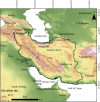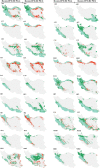Response of Iranian lizards to future climate change by poleward expansion, southern contraction, and elevation shifts
- PMID: 35149739
- PMCID: PMC8837782
- DOI: 10.1038/s41598-022-06330-4
Response of Iranian lizards to future climate change by poleward expansion, southern contraction, and elevation shifts
Abstract
This study explores the relationships between recent Iranian lizard species distributions and the observed climate, as well as potential future distributions of species. For this purpose, an ensemble of seven algorithms was used to forecast the distributions of 30 species for the recent and future (2070) based on the averages of 14 global climate models under optimistic (RCP2.6) and pessimistic (RCP8.5) scenarios. Annual precipitation (n = 16) and annual mean temperature (n = 7) were identified as the most important variables in determining the distribution of 76.66% (23 out of 30) of the species. The consensus model predicts that the ranges of 83.33% of species (n = 25) have the potential to expand poleward at higher latitudes while preserving the majority of their recent distributions (except for four species). Furthermore, the ranges of the remaining species (n = 5) will be preserved at higher latitudes. However, they (n = 22) may contract slightly (n = 13) or excessively (n = 9) in the south of their distribution range at lower latitudes. These results indicate that species (N = 19) situated in mountainous areas such as the Zagros, Alborz, and Kopet Dagh may move or maintain their range at higher elevations as a result of future climate change. Finally, this study suggests that 30% of species (n = 9) may be threatened by future climate change and that they should be prioritized in conservation efforts.
© 2022. The Author(s).
Conflict of interest statement
The author declares no competing interests.
Figures





Similar articles
-
The influence of climate change on the suitable habitats of Allium species endemic to Iran.Environ Monit Assess. 2022 Feb 11;194(3):169. doi: 10.1007/s10661-022-09793-0. Environ Monit Assess. 2022. PMID: 35146574
-
Reptile species richness associated to ecological and historical variables in Iran.Sci Rep. 2020 Oct 23;10(1):18167. doi: 10.1038/s41598-020-74867-3. Sci Rep. 2020. PMID: 33097758 Free PMC article.
-
How will climate change impact fossorial lizard species? Two examples in the Baja California Peninsula.J Therm Biol. 2021 Jan;95:102811. doi: 10.1016/j.jtherbio.2020.102811. Epub 2020 Dec 14. J Therm Biol. 2021. PMID: 33454041
-
Diversity and Distribution Patterns of Endemic Medicinal and Aromatic Plants of Iran: Implications for Conservation and Habitat Management.Int J Environ Res Public Health. 2022 Jan 29;19(3):1552. doi: 10.3390/ijerph19031552. Int J Environ Res Public Health. 2022. PMID: 35162573 Free PMC article. Review.
-
Get real: putting models of climate change and species interactions in practice.Ann N Y Acad Sci. 2013 Sep;1297:126-38. doi: 10.1111/nyas.12175. Epub 2013 Jun 24. Ann N Y Acad Sci. 2013. PMID: 23796014 Review.
Cited by
-
Global warming intensifies the interference competition by a poleward-expanding invader on a native dragonfly species.R Soc Open Sci. 2023 Nov 22;10(11):230449. doi: 10.1098/rsos.230449. eCollection 2023 Nov. R Soc Open Sci. 2023. PMID: 38026017 Free PMC article.
-
Different response of a native dragonfly species against a neonative invader along a latitudinal gradient.iScience. 2025 Jun 13;28(7):112887. doi: 10.1016/j.isci.2025.112887. eCollection 2025 Jul 18. iScience. 2025. PMID: 40687792 Free PMC article.
-
Climate-driven distribution shifts of Iranian amphibians and identification of refugia and hotspots for effective conservation.Sci Rep. 2024 Dec 30;14(1):31610. doi: 10.1038/s41598-024-79293-3. Sci Rep. 2024. PMID: 39738262 Free PMC article.
References
-
- Araújo MB, Rahbek C. How does climate change affect biodiversity? Science. 2006;80(313):1396–1397. - PubMed
-
- Pereira HM, et al. Scenarios for global biodiversity in the 21st century. Science. 2010;80(330):1496–1501. - PubMed
-
- Walther G-R, et al. Ecological responses to recent climate change. Nature. 2002;416:389–395. - PubMed
-
- McCarty JP. Ecological consequences of recent climate change. Conserv. Biol. 2001;15:320–331.
-
- Root TL, et al. Fingerprints of global warming on wild animals and plants. Nature. 2003;421:57–60. - PubMed
MeSH terms
LinkOut - more resources
Full Text Sources
Medical

